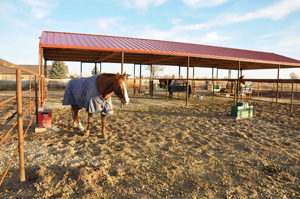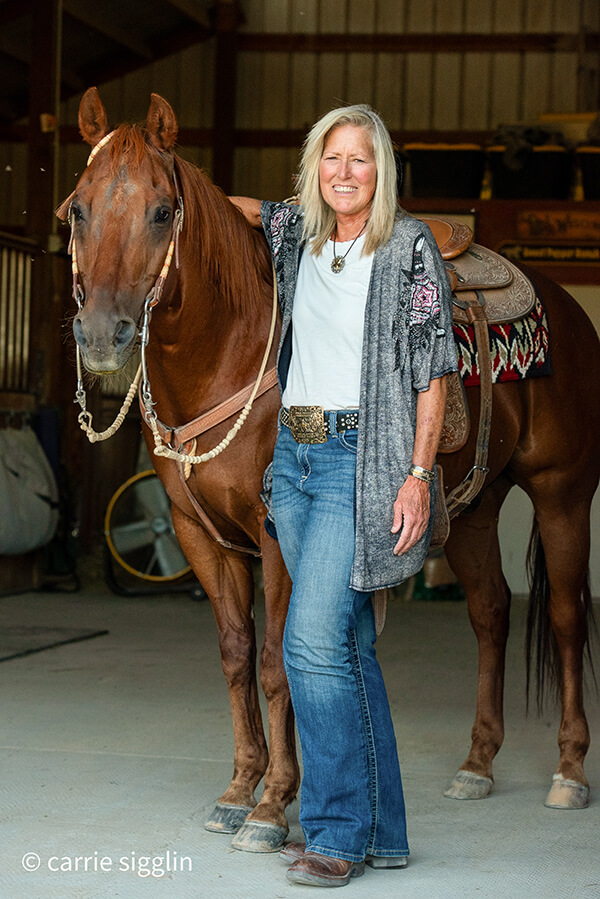Sacrifice Areas Essential for Pasture Health
by Alayne Blickle
Probably the most important aspect of managing pasture is the time when you take your horses off your pasture. Grasses should not be grazed below 3-4 inches, and horses should not be on pasture when soil is saturated. You can greatly improve the health and productivity of your pastures by creating and using a paddock or “sacrifice area” to confine your horses during this time.

A good option is to have one sacrifice area per horse set up like a run-off of each stall. This chore-efficient arrangement gives the horse free access to the stall, plus you have a clean, dry, convenient place to feed.
Begin by locating an appropriate site for your sacrifice area that is:
- On higher ground
- Away from creeks, wetlands or other water bodies and from surface water flows
- Surrounded by a grassy or vegetated buffer for biofiltration of any runoff
- Convenient to your barn to make it easy for you to care for your horse and maintain the area
Size – A sacrifice area can vary in size from a generous box stall (16 x16 feet) to a long, narrow enclosure where the horse could trot or even gallop to get some exercise. For a horse to run or play in his paddock, an enclosure of about 20 to 30 feet wide by 100 feet long is needed. The amount of land you have available, the number of horses, their ages, temperaments and the amount of regular exercise they receive all play an important role in planning the size of your sacrifice area(s).
Footing is a key consideration for sacrifice areas. Using some type of footing, at least in the high traffic areas, will prevent erosion and reduce mud. Mud management is as important for the health of the environment as it is for the health of your horse (and for your convenience). Hog fuel or wood chips can provide an excellent footing. Gravel (crushed rock, no larger than 5/8”) or sand work well in some situations, although you should avoid feeding your horse on these surfaces. Ingesting sand or mud with hay can result in serious sand colic problems and expensive vet bills.
Install rain gutters and downspouts on all barns, sheds and outbuildings to divert the clean rainwater away from high traffic areas. This will substantially reduce the amount of mud created in your sacrifice areas during the rainy season. Environmentally this is important because diverting rainwater keeps nutrients (from manure and urine) and sediments (from soil) out of surface waters.
Choose the safest fencing you can for your sacrifice area. Whatever type of fencing you choose, you may want to reinforce it with some type of electric tape or hot wire — a good psychological barrier. Horses are hard on fences and will test most types but they tend to respect electric fencing.
Pick up manure every one to three days to help reduce your horse’s parasite load as well as reducing flies, insects, and mud.
Be sure that corners are safe and there are no protruding objects where the horse could get hurt, like bolt ends, nails, boards, or the tops of metal T-posts. Watch out for roof edges and the bottom of metal buildings. There should be no wires or cords hanging in the area and absolutely no junk, garbage or machinery.
Keep in mind that gates on fences need to be adequately sized for the types of truck deliveries you expect (such as gravel, hog fuel, hay). Latches should be easy to open. Both these points will make chore-time easier to handle.
Even though your horses can move around in their sacrifice areas, they still need regular exercise. Be sure to plan for and maintain a regular exercise program for your horse.
Join Horses for Clean Water at these free learning opportunities:
MAPLE VALLEY, WA
Maple Valley Library
Wednesday, May 3, 1 – 3 pm
WORKSHOP: Wipe Out Plastics in Your Everyday Life
FREE! Register: kingcd.eventbrite.com, (425) 282-1949 or [email protected]
SNOQUALMIE, WA
Sunday, May 7, 12:30 – 2:30 pm
FARM TOUR: Mud-free Picturesque Horse Property
FREE! Register: kingcd.eventbrite.com, (425) 282-1949 or [email protected]
SNOQUALMIE, WA
Sunday, May 7, 3 – 4 pm
WORKSHOP: Intro to Agritourism & Ecotourism
FREE! Register: kingcd.eventbrite.com, (425) 282-1949 or [email protected]
THURSTON COUNTY, WA
Kiperts Korner, Olympia
Saturday, June 3, 3 pm – 6 pm
WORKSHOP: Control Mud, Dust, Bugs & Weeds – for Horse & Small Acreage Livestock Owners
Details & registration: [email protected] or (360) 754-3588 ext. 105
Originally Publishes May 2017 Issue

Alayne Blickle began in the 1990’s as a pioneer in water conservation and natural resources conservation by creating the entrepreneurial consulting business, Horses for Clean Water, an award-winning internationally acclaimed education program that looks for horse-healthy, nature-based solutions to land management challenges. She continues this work today partnering with agencies, organizations, and horse owners throughout North America and worldwide. She is a regularly contributing writer and photojournalist to several equine publications.
Alayne lives with her horse trainer husband, Matt Livengood, in southwestern Idaho where they raise and train AQHA horses and mustangs on their eco-friendly horse ranch. Contact her through the Horses for Clean Water website or through their ranch website Sweet Pepper Ranch.
For more information contact Alayne at [email protected] or 206-909-0225.






